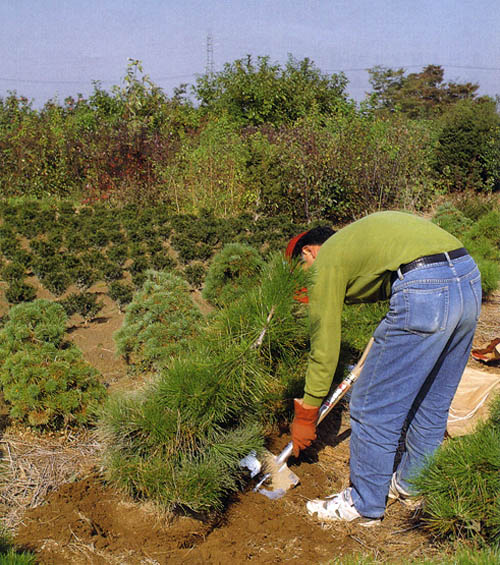
Digging a field grown Japanese Black Pine. From Bonsai Today, issue 75.
In Field Growing 2 I said I just dug a hole and planted. Actually, that isn’t the whole story; when you field grow bonsai stock, you need to cut off the downward growing roots and spread the lateral roots. This encourages lateral top growth (above ground growth) and nebari development (check the top photo in Field Growing 2).
Some people put a board, or tile, or some other flat object a few inches under the roots to inhibit downward root growth and encourage lateral growth. Others, like me, just dig their plants up every couple years and prune and spread the roots each time.
The disadvantage to too much digging and rootpruning, is that it sets back growth for awhile, so the plants develops more slowly. The advantage is; you can do some top pruning when you have them out of the ground.
Though not everyone would agree with this approach (they might say something like; just let them grow and do the refining later when they are in containers), I like it because I get to know my trees better and enjoy having partially styled future bonsai in my landscaping. I also like it because I’m impatient and can’t wait to get started shaping. I even have some in the ground with wire (got to watch it because in-ground stuff grows fast) and even some with branch benders hanging on them (I’ll have some photos for you when the snow melts).
Note: in Field Growing 2 I used the term native soil. What I meant was just whatever soil is already there, not necessarily the soil that was there before any humans came along and altered it. In most areas where people live all kinds of things may have been done to the soil over the years that alter it’s original composition.
Check out our previous posts on field growing: Have You Thought About Field Growing? and Field Growing 2: Native Soil
You have certainly presented an interesting concept for getting the lateral development of the roots in in-ground bonsai stock. I personally have at least two plants with which to try the methods you have discussed. it will be interesting to see what sort of results I can develop.
Thanks,
Kit
I use the board method and it seems to work great although most boards will deteriorate within 2-3 years and you will still require digging up. It does, however, prevent deep roots from developing and thereby reduces the amount of work required to dig up and potential damage to the root structure.
-EK
I have a small back yard and made a 6-9 inch deep pit and placed a fiberglass sheet at about a sq ft just below the root area and i find that i have a great nebari deing developed . The plants were nursery grown for 2 years and now it is almost two years in the pit. I guess it will be easy to lift off too with minimum root damage.
anjali